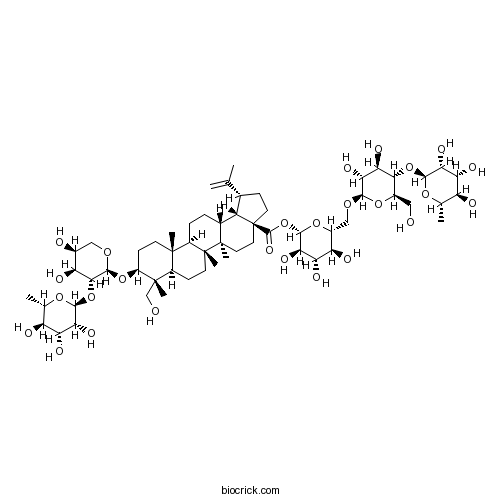| Catalog No. | BCN1276 |  |
|
| CAS RN | 129741-57-7 | ||
| Molecular Weight | 1221.38 | ||
| Molecular Formula | C59H96O26 | ||
| Database | [PubChem]:382154851 [ChEBI]: [PCIDB]: |
||
InChI=1S/C59H96O26/c1-23(2)26-11-16-59(54(75)85-52-45(73)41(69)38(66)30(81-52)21-77-49-46(74)42(70)47(29(19-60)80-49)83-50-43(71)39(67)35(63)24(3)78-50)18-17-57(7)27(34(26)59)9-10-32-55(5)14-13-33(56(6,22-61)31(55)12-15-58(32,57)8)82-53-48(37(65)28(62)20-76-53)84-51-44(72)40(68)36(64)25(4)79-51/h24-53,60-74H,1,9-22H2,2-8H3/t24-,25-,26-,27+,28-,29+,30+,31+,32+,33-,34-,35-,36-,37-,38+,39+,40+,41-,42+,43+,44+,45+,46+,47+,48+,49+,50-,51-,52-,53-,55-,56-,57+,58+,59-/m0/s1
Anemoside B4(AB4) and tetrandrine(Tet) have some reversal effect on resistant to L-OHP in Lo Vo/L-OHP cells, the molecular mechanism of the resistance reverse effect was related to down-regulation of P-gp for AB4 and down-regulation of z DHHC9 for Tet.[1]
Anemoside B4, anemonin, berberine, jatrorrhizine, palmatine, aesculin, and esculetin are active ingredients of Pulsatillae Decoction , can inhibit the production of IL-6,secretion of IL-8, downregulate E-selectin expression, and decrease the content of TXB(2), they reduce inflammatory response, thus relieving intestinal dysfunction via multiple pathways.[2]
Anemoside B4 might potentially have a capacity to regulate immune responses in vivo via changes in production of these select cytokines by infected endothelial cells.[3]
English website: Anemoside B4
Japanese website: Anemoside B4
Chinese website: Anemoside B4
[1] Min L I, Fang M, Oncology D O. China Oncology, 2015(1):38-44.
[2] Hu Y, Chen X, Duan H, et al. Immunopharm Immunot, 2009, 31(4):550-5.
[3] Hu Y, He K, Wang X. J Immunotoxicol, 2016, 13(2):141-7.
[4] Yeom H S, Suh J H, Youm J R, et al. Bulletin- Korean Chemical Society, 2010, 31(5):1159-64.


